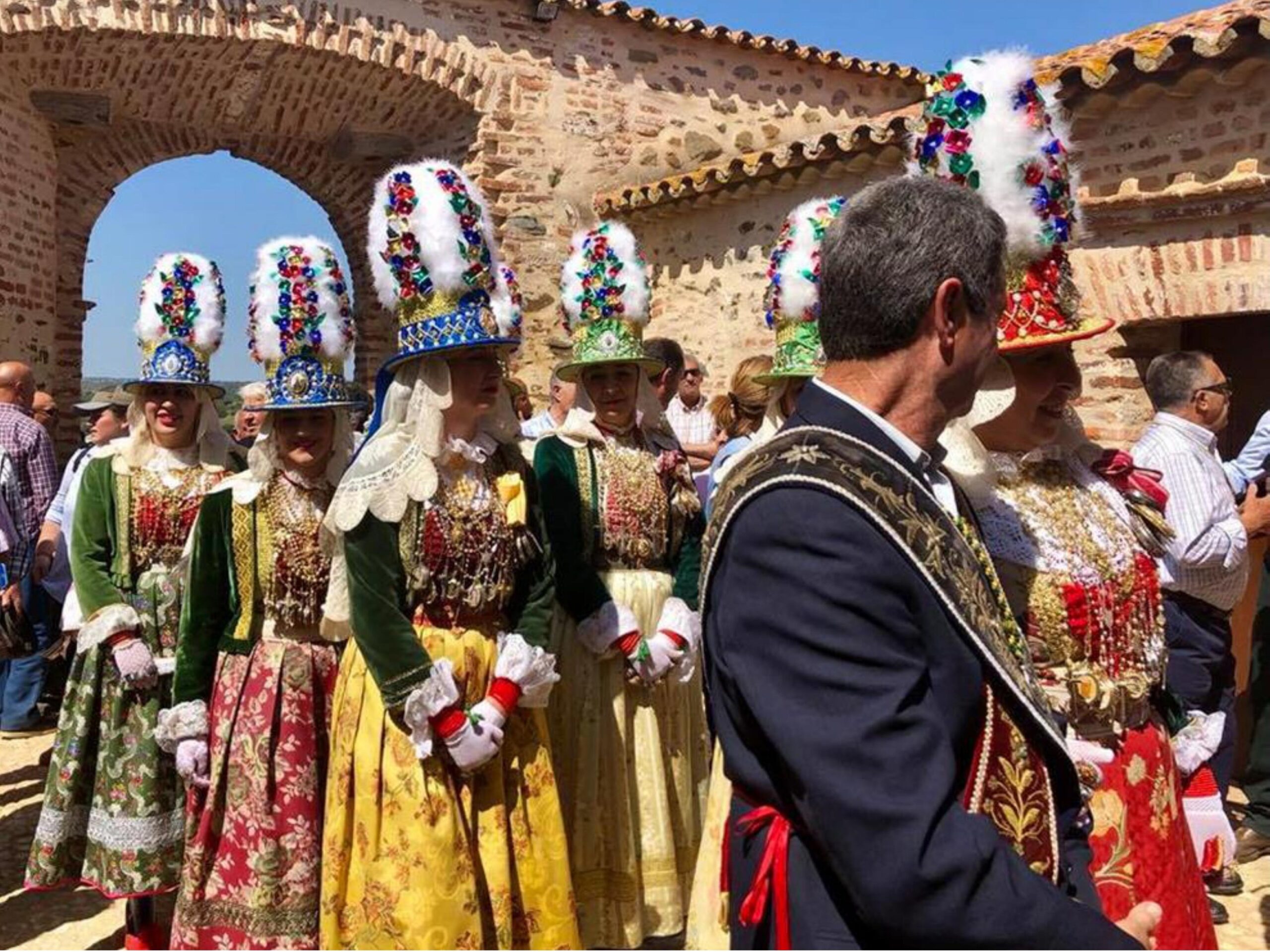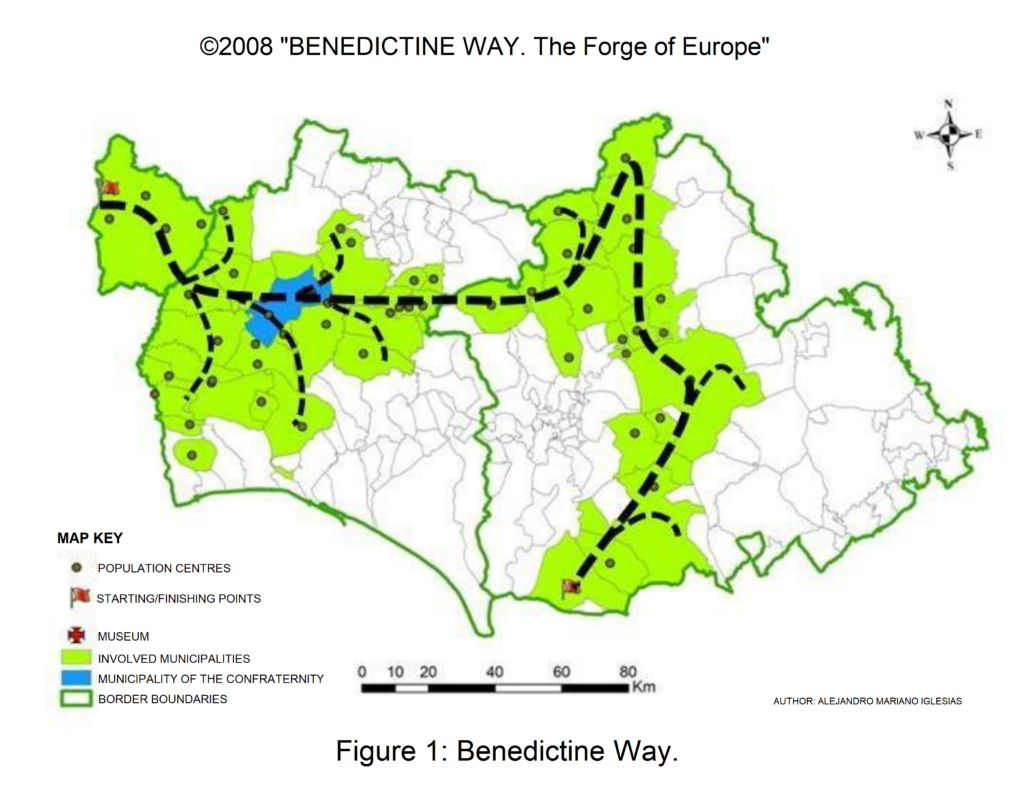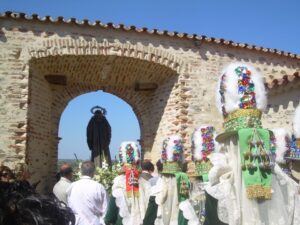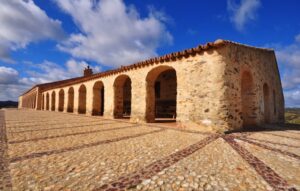
I would like to begin by thanking Future for Religious Heritage for the invitation to share the ideas and progress on this particular project of socio-cultural rootedness where a multicausality of factors will help vertebrate the cross-border region of Andévalo, between Spain and Portugal, where the shared culture allows us to recognise ourselves both as a social group and as individual beings.
The project “BENEDICTINE WAY. The Forge of Europe” was born with the intention of establishing a cultural-religious itinerary through the legacy of Benedict of Nursia in the region of Andévalo, in the South of Southern Europe, which comprises 61 Spanish and Portuguese municipalities (34 from the province of Huelva, 21 from the province of Seville and 6 Portuguese) with shared socio-cultural values. Our goal with this initiative is to improve the life of the 387. 302 registered inhabitants of the region, improve the infrastructures along 10,024 km², and create 976 rural tourism places (see Figure 1) to ensure the preservation and promotion of its cultural and religious heritage and bring new life to their villages.
Taking forward cultural initiatives like this one, born out of non-profit organisations, is tremendously complex. On the other hand, they allow greater freedom to foster, complement and incorporate professional vocations and talent from civil society. In the following paragraphs I will try to convey to you my personal conviction about the current scenario of religious heritage in this specific region and the opportunities that heritage represents for European rural areas after the Covid-19 pandemic through 7 reasons which are the raison d’être of the project “BENEDICTINE WAY. The Forge of Europe”.
The first reason is that it provides the younger generation, most of whom are the children of migrants who moved from the countryside to the city decades ago, with an excellent opportunity to put their talents to work, reconnect with their roots, and regain a sense of belonging to the rural community through new employment opportunities linked to heritage and traditional trades. Heritage conservation in rural areas depends to a large extent on the arrival of young people. It is a challenge and an opportunity waiting to be seized.

This brings us to the second reason, which is to facilitate the conversion of El Andévalo into a Cultural Tourism Region. This will help us preserve the historical memory of the region and become an attractive niche for industrial and entrepreneurial networks, thus mitigating the problems related to generational replacement.
The third reason for this civil and cultural initiative has to do with the recognition of rural values, and how it improves the future of the region in terms of employment, digital transformation, agricultural and livestock activity, tourism, etc. This project will bring together a generation born in cities (descendants of parents and grandparents who migrated from the countryside to the cities), who have a university education and the capacity to get involved and cooperate in civic-cultural projects, with rural young people and families without high academic qualifications but who are irreplaceable witnesses of the region’s intangible heritage.
As a fourth reason, this cultural project will deepen the direct and continuous interrelation of the people of the Andévalo region, who constitute a cultural group with common characteristics that could lead one to consider them as an “ethnic group”, in my opinion, as they are a human community defined by linguistic, cultural affinities, etc. Strengthening their bonds and fostering communication will allow the community to protect and maintain the set of traditions, beliefs, religious ceremonies, and other cultural manifestations that make up the intangible heritage of the Andévalo region, from its Romería de San Benito Abad (promoted by one of the oldest confraternities in Europe with 428 years of history) to the mining social culture of the Faja Piritica area in the European Southwest.

Parade in honour of St Benedict of Nursia in the village of “El Cerro de Andévalo”. © “CAMINO BENEDICTINO . La forja de europa”.
The fifth reason has to do with the need to recognise and congratulate ourselves on how all sorts of vicissitudes did not spoil our impressive social, aesthetic and economic territorial legacy. It is a duty to history to acknowledge all previous generations of men and women for their essential role in the protection of their cultural heritage, a protection based on mutual support.
The sixth reason is the importance of this project as a link between the neo-rural urbanites, without previous roots in the territory, who will be attracted by the opportunities of the Cultural Tourism Region and our rural families and our rural youth, who can act as “cultural interpreters”, as they know better than anybody else the reality of the territory and its culture. These local families and young people are at the same time key to offering a friendly welcome to newcomers, and contributing to the creation of a new cultural group, inspired by the Benedictine rule of coexistence that still permeates their worldview, rites and social customs.
The seventh reason for the project is to enhance the structuring role of our movable and immovable religious heritage. This religious material and immaterial heritage gives foundation to beliefs and customs with centuries of tradition and constitutes the backbone of the Cultural Tourism Region of Andevalo and its surrounding municipalities of Huelva, Seville and Alentejo. The “BENEDICTINE WAY. The forge of Europe” highlights the core importance of the Catholic tradition in the region, with a fair recognition to religious brotherhoods for their historical and social significance and to bishoprics for their responsibility for the maintenance of this cultural-religious structure. In turn, this project will give more weight to the bishoprics to decide how they want to be recognised and respected by future visitors to the Cultural Tourism Region and by the new inhabitants of the territory, to manage the reception of pilgrims and tourists when there is a greater presence of visitors and to decide if they want the new industries and entrepreneurs to play a role or participate in the spiritual life of the territory.

Hermitage of St Benedict of Nursia in the village of “Montes de San Benito”. © “CAMINO BENEDICTINO . La forja de europa”.
For all the above reasons, the achievement of the Cultural Tourist Region requires the participation of all the entities of the territory that must be involved by the competent administration for a correct execution and effective help on the European policies that are asking us to make way to gravitate territorial solutions of employment that go through making the religious heritage and its influence in the territory the genesis of an improvement in the quality of life for which enormous economic resources will be available that will help to recover and/or activate 26 niches of employment.
The very important weight of the cultural heritage in this Cultural Tourist Region, the role played by our Christian temples and subsequently to all their dedications, patron saint festivals, popular customs and way of enjoying life and understanding the world that we have in the South of Southern Europe allows us to enjoy it all the seasons of the year.
Hoping that this article has provided another vision of our rural world with a shared perspective of hope for the recovery of work and discovering together new keys for our personal and professional improvement, all of which allows us to assert that the rural world represents us all culturally and only if we protect it together, we will avoid its disappearance.
By Carmen Corchero Corchero, historian and archaeologist specialised in cultural heritage and researcher of the Universidad Complutense of Madrid (UCM) and National Distance Education University (UNED). She is the director of DIPSOC, a non-profit organisation to revitalise rural areas through cultural material and immaterial heritage.





Follow us: